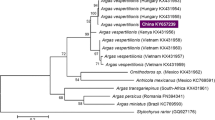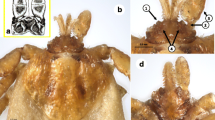Abstract
Bats represent the second order of mammals with the highest number of species worldwide with over 1,616 species, and almost 10% of them are recorded in Mexico. These mammals have a great diversity of ectoparasites, in particular soft ticks of the genus Ornithodoros. Desmodus rotundus is one of the bat species that has scarcely been studied in terms of tick species richness in Mexico, with three tick species reported in five of the 32 Mexican states. For this reason, the aim of the present work was to identify ticks associated with D. rotundus from Central Mexico. Fieldwork was undertaken in the municipality El Marqués, Ejido Atongo A, Querétaro, Mexico. Bats were captured using mist nets and were visually inspected for tick presence. The ectoparasites were identified morphologically and molecularly with the use of mitochondrial markers 16SrDNA and cytochrome oxidase subunit I (COI). A total of 30 D. rotundus (1 female, 29 males) were captured, from which 20 larvae identified as Ornithodoros yumatensis were recovered. Molecular analysis confirmed the presence of this species with identity values of 99–100% with sequences of this species from the southwestern US, and the Yucatán Peninsula, Mexico. This is the first report of ticks associated with bats for the state of Querétaro, providing the first sequences of the COI gene from Mexican populations of O. yumatensis and shows an increase in the distribution of this soft tick across Central Mexico.





Similar content being viewed by others
Data availability
The data that support the results of this study are available in GenBank, under the following accession numbers O. yumatensis 16S-rDNA (OP984615-OP984630) and COI (OQ048385-OQ048392).
References
Aguilar-Domínguez M, Sánchez-Montes S, Esteve-Gassent MD, Barrientos-Salcedo C, Pérez de León A, Romero-Salas D (2019) Genetic structure analysis of Amblyomma mixtum populations in Veracruz State, Mexico. Ticks Tick Borne Dis 10(1):86–92. https://doi.org/10.1016/j.ttbdis.2018.09.004
Bain JR, Zinn TL (1982) Ornithodoros yumatensis from the southeastern brown bat (Myotis austroriparius) in Florida. J Parasitol 68(3):510–511
Bradshaw GVR, Ross A (1961) Ectoparasites of Arizona Bats. J Ariz-Nev Acad Sci 1(4):109–112. https://doi.org/10.2307/40026556
Ceballos G (2014) Mammals of Mexico. Johns Hopkins University Press, Baltimore
Chitanga S, Chambaro HM, Moonga LC et al (2021) Rickettsia lusitaniae in Ornithodoros porcinus Ticks. Zambia Pathogens 10(10):1306. https://doi.org/10.3390/pathogens10101306
Cooley RA, Kohls GM (1941) Three new species of Ornithodoros (Acarina: Ixodoidea). Pub Health Rep 56:587–594
Cooley RA, Kohls GM (1944) The Argasidae of North America, Central America and Cuba. Amer Midl Naturalist Monogr 1:1–152
Dooley TJ, Bristol JR, Canaris AG (1976) Ectoparasites from bats in extreme west Texas and south-central New Mexico. J Mammal 57(1):189–191
Folmer O, Black M, Hoeh W, Lutz R, Vrijenhoek R (1994) DNA primers for amplification of mitochondrial cytochrome c oxidase subunit I from diverse metazoan invertebrates. Mol Mar Biol Biotechnol 3(5):294–299
Guzmán-Cornejo C, García-Prieto L, Rebollo-Hernández A, Venzal JM, Nava S, Sánchez-Montes S (2017) Molecular evidence and additional morphological characters to distinguish Ornithodoros brodyi and Ornithodoros yumatensis (Ixodida: Argasidae) in their different developmental stages. Acta Parasitol 62(2):432–448. https://doi.org/10.1515/ap-2017-0051
Guzmán-Cornejo C, Herrera-Mares A, Robbins RG, Rebollo-Hernández A (2019) The soft ticks (Parasitiformes: Ixodida: Argasidae) of Mexico: species, hosts, and geographical distribution. Zootaxa 4623(3). https://doi.org/10.11646/zootaxa.4623.3.3
Herrera MLG, Ortega-García S, Morales-Malacara JB, Flores-Martínez JJ, López-Ortega G, Richman AD (2016) Geographical and seasonal patterns of spleen mass and acarine load in tropical and subtropical leaf-nosed bats. Acta Chiropt 18:517–526. https://doi.org/10.3161/15081109ACC2016.18.2.018
Hornok S, Szőke K, Meli ML, Sándor AD, Görföl T, Estók P, Wang Y, Tu VT, Kováts D, Boldogh SA, Corduneanu A, Sulyok KM, Gyuranecz M, Kontschán J, Takács N, Halajian A, Epis S, Hofmann-Lehmann R (2019) Molecular detection of vector-borne bacteria in bat ticks (Acari: Ixodidae, Argasidae) from eight countries of the Old and New Worlds. Parasit Vectors 12(1):50. https://doi.org/10.1186/s13071-019-3303-4
Jones C, Manning RW (1989) Myotis austroriparius. Mamm Species 332:1–3. https://academic.oup.com/mspecies/article/doi/10.2307/3504306/2600323
Kim HC, Jiang J, Hang J et al (2021) Detection of Rickettsia lusitaniae Among Ornithodoros sawaii Soft Ticks Collected From Japanese Murrelet Seabird Nest Material From Gugul Island. Republic of Korea J Med Entomol 58(3):1376–1383. https://doi.org/10.1093/jme/tjab005
Lado P, Nava S, Labruna MB, Szabo MPJ, Durden LA, Bermudez S, Montagna M, Sánchez Quirós AC, Beati L (2016) Amblyomma parvum Aragão, 1908 (Acari: Ixodidae): Phylogeography and systematic considerations. Ticks Tick Borne Dis 7(5):817–827. https://doi.org/10.1016/j.ttbdis.2016.03.017
Lees AD (1947) Transpiration and the structure of the epicuticle in ticks. J Exp Biol 23(3–4):379–410. https://doi.org/10.1242/jeb.23.3-4.379
López-González CA, Coronel-Arellano H, Hernández-Camacho N (2016) Mamíferos del estado de Querétaro. In: Jones RW, Serrano-Cárdenas V (eds) Historia Natural de Querétaro. Universidad Autónoma de Querétaro, Editoria Universitaria, pp 283–299
Mans BJ, Featherston J, Kvas M, Pillay KA, de Klerk DG, Pienaar R, de Castro MH, Schwan TG, Lopez JE, Teel P, Pérez de León AA, Sonenshine DE, Egekwu NI, Bakkes DK, Heyne H, Kanduma EG, Nyangiwe N, Bouattour A, Latif AA (2019) Argasid and ixodid systematics: Implications for soft tick evolution and systematics, with a new argasid species list. Ticks Tick Borne Dis 10(1):219–240. https://doi.org/10.1016/j.ttbdis.2018.09.010
Medellín RA, Arita HT, Sánchez O (2007) Identificación de los murciélagos de México, Clave de campo. Instituto de Ecología, UNAM, Second Edition, p 80
Meza DK, Mollentze N, Broos A et al (2022) Ecological determinants of rabies virus dynamics in vampire bats and spillover to livestock. Proc Biol Sci 289(1982):20220860. https://doi.org/10.1098/rspb.2022.0860
Milhano N, Palma M, Marcili A, Núncio MS, de Carvalho IL, de Sousa R (2014) Rickettsia lusitaniae sp. nov. isolated from the soft tick Ornithodoros erraticus (Acarina: Argasidae). Comp Immunol Microbiol Infect Dis 37(3):189–193. https://doi.org/10.1016/j.cimid.2014.01.006
Morrone JJ (2020) The Mexican Transition Zone: A Natural Biogeographic Laboratory to Study Biotic Assembly Springer Cham. Springer Nature Switzerland, p 191
Muñoz-Leal S, Faccini-Martínez ÁA, Pérez-Torres J, Chala-Quintero SM, Herrera-Sepúlveda MT, Cuervo C, Labruna MB (2021) Novel Borrelia genotypes in bats from the Macaregua Cave, Colombia. Zoonoses Public Health 68(1):12–18. https://doi.org/10.1111/zph.12789
Nadolny RM, Kennedy AC, Rodgers JM et al (2021) Carios kelleyi (Acari: Ixodida: Argasidae) Infected With Rickettsial Agents Documented Infesting Housing in Kansas, United States. J Med Entomol 58(6):2398–2405. https://doi.org/10.1093/jme/tjab069
Norris DE, Klompen JS, Keirans JE, Black WC (1996) Population genetics of Ixodes scapularis (Acari: Ixodidae) based on mitochondrial 16S and 12S genes. J Med Entomol 33(1):78–89. https://doi.org/10.1093/jmedent/33.1.78
Nowak RM (1994) Walker’s bats of the world. John Hopkins University Press, Baltimore
Paradis E, Schliep K (2019) ape 5.0: an environment for modern phylogenetics and evolutionary analyses in R. Bioinformatics 35(3):526–528. https://doi.org/10.1093/bioinformatics/bty633
Qiu Y, Simuunza M, Kajihara M et al (2021) Screening of tick-borne pathogens in argasid ticks in Zambia: Expansion of the geographic distribution of Rickettsia lusitaniae and Rickettsia hoogstraalii and detection of putative novel Anaplasma species. Ticks Tick Borne Dis 12(4):101720. https://doi.org/10.1016/j.ttbdis.2021.101720
Ramírez-Pulido J, González-Ruiz N, Gardner AL, Arroyo-Cabrales J (2014) List of recent land mammals of Mexico. Spec Publ Mus Tex Tech Univ 63:1–69
Ruber F, Brugger K, Haslinger K, Auer I (2017) The climate of the European Alps: Shift of very high resolution Köppen-Geiger climate zones 1800–2100. Meteorol Z 26(2):115–125. https://doi.org/10.1127/metz/2016/0816
Sage KM, Johnson TL, Teglas MB, Nieto NC, Schwan TG (2017) Ecological niche modeling and distribution of Ornithodoros hermsi associated with tick-borne relapsing fever in western North America. Plos Negl Trop Dis 11(10):e0006047. https://doi.org/10.1371/journal.pntd.0006047
Sánchez-Montes S, Guzmán-Cornejo C, Martínez-Nájera Y, Becker I, Venzal JM, Labruna MB (2016) Rickettsia lusitaniae associated with Ornithodoros yumatensis (Acari: Argasidae) from two caves in Yucatan, Mexico. Ticks Tick Borne Dis 7(6):1097–1101. https://doi.org/10.1016/j.ttbdis.2016.09.003
Sánchez-Montes S, Blum-Domínguez S, Lozano-Sardaneta YN et al (2021a) Molecular detection of Rickettsia sp. cf. Rickettsia monacensis in Ixodes sp. cf. Ixodes affinis collected from white-tailed deer in Campeche, Mexico. Parasitol Res 120(5):1891–1895. https://doi.org/10.1007/s00436-021-07128-5
Sánchez-Montes S, Colunga-Salas P, Lozano-Sardaneta YN, Zazueta-Islas HM, Ballados-González GG, Salceda-Sánchez B, Huerta-Jiménez H, Torres-Castro M, Panti-May JA, Peniche-Lara G, Muñoz-García CI, Rendón-Franco E, Ojeda-Chi MM, Rodríguez-Vivas RI, Zavala-Castro J, Dzul-Rosado K, Lugo-Caballero C, Alcántara-Rodríguez VE, Delgado-de la Mora J, Licona-Enríquez JD, Delgado-de la Mora D, López-Pérez AM, Álvarez-Hernández G, Tinoco-Gracia L, Rodríguez-Lomelí M, Ulloa-García A, Blum-Domínguez S, Tamay-Segovia P, Aguilar-Tipacamú G, Cruz-Romero A, Romero-Salas D, Martínez-Medina MA, Becker I (2021b) The genus Rickettsia in Mexico: Current knowledge and perspectives. Ticks Tick Borne Dis 12(2):101633. https://doi.org/10.1016/j.ttbdis.2020.101633
Sándor AD, Mihalca AD, Domşa C, Péter Á, Hornok S (2021) Argasid Ticks of Palearctic Bats: Distribution, Host Selection, and Zoonotic Importance. Front vet sci 8:684737. https://doi.org/10.3389/fvets.2021.684737
Teglas MB, May B, Crosbie PR, Stephens MR, Boyce WM (2005) Genetic structure of the tick Ornithodoros coriaceus (Acari: Argasidae) in California, Nevada, and Oregon. J Med Entomol 42:247–253. https://doi.org/10.1093/jmedent/42.3.247
Villegas-Guzman GA, López-González C, Vargas M (2005) Ectoparasites associated to two species of Corynorhinus (Chiroptera: Vespertilionidae) from the Guanaceví mining region, Durango. Mexico J Med Entomol 42(2):125–127. https://doi.org/10.1093/jmedent/42.2.125
Wickham H (2016) ggplot2: Elegant Graphics for Data Analysis. Springer-Verlag, New York, p 182
Wilson DE, Reeder DM (2005) Mammal species of the world: A taxonomic and geographic reference. Vols. 1 & 2. 3rd Edition. Johns Hopkins University Press, Maryland p 2142
Winston PW, Bates DH (1960) Saturated solutions for the control of humidity in biological research. Ecology 41(1):232–237. https://doi.org/10.2307/1931961
Acknowledgements
We thank Berenit Mendoza Garfias for preparing the scanning electron micrographs and Lucia Álvarez-Castillo for their support in editing the micrographs and generating the slide.
Funding
The project was financed by FONDEC: FNB-2021–05.
Author information
Authors and Affiliations
Contributions
Fieldwork: EG, CIMC, KDVM, GAL, GAT.
Conceived and designed the experiments: EG, SSM, PCS, CALG, GAT.
Performed the experiments: EG, CIMC, SSM.
Analyzed the data: EG, CIMC, SSM, PCS, CALG, KDVM, GAL, GAT.
Contributed reagents/materials/analysis tools: SSM, PCS, CALG, GAT.
Wrote the paper: EG, CIMC, SSM, PCS, CALG, KDVM, GAL, GAT.
Corresponding author
Ethics declarations
Ethical approval
This study was approved by the Bioethics committee of the Faculty of Natural Sciences of Autonomous University of Queretaro. Bats were captured under permissions SGPA/DGVS/03444/20 and SPARN/DGVS/02164/22 from the Ministry of Environment and Natural Resources.
Competing interests
The authors certify that they have no affiliations with or involvement in any organization or entity with any financial interest, nonfinancial interest in the subject matter or materials discussed in this manuscript.
Additional information
Publisher's note
Springer Nature remains neutral with regard to jurisdictional claims in published maps and institutional affiliations.
Rights and permissions
Springer Nature or its licensor (e.g. a society or other partner) holds exclusive rights to this article under a publishing agreement with the author(s) or other rightsholder(s); author self-archiving of the accepted manuscript version of this article is solely governed by the terms of such publishing agreement and applicable law.
About this article
Cite this article
Grostieta, E., Miranda-Caballero, C.I., Sánchez-Montes, S. et al. DNA barcoding and new records of Ornithodoros yumatensis from Central Mexico. Vet Res Commun 47, 2339–2350 (2023). https://doi.org/10.1007/s11259-023-10164-4
Received:
Accepted:
Published:
Issue Date:
DOI: https://doi.org/10.1007/s11259-023-10164-4




